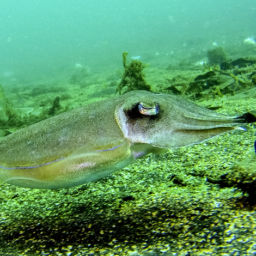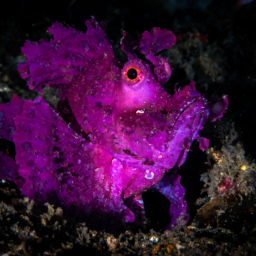Arriving at night, we were denied the view of Lembeh Resort on Lembeh Island. Just off the northeastern corner of North Sulawesi, it’s tucked into a small, lush cove. The resort spills up the hillside, rooms and bungalows partially obscured by the riotous foliage. To get here, my dive buddies and I flew first from Bali to Manado, in North Sulawesi. Then we hopped on board a Lembeh Resort van for the 90-minute drive to the port city of Bitung. From there it was a short boat ride over to Lembeh Island.
The trip was worth it though — Lembeh, as most divers know, is mecca for muck divers. The area’s black sands are home to an absolutely astonishing variety of bucket-list critters. From blue-ringed octopus to hairy frogfish, warty frogfish, pipefish, cuttlefish — you name it, you’ll see it. With 16 full-time guides, the resort’s onsite dive shop, Critters@Lembeh Resort, will help you check them all off your bucket list.
Guides here aren’t just guides either. With a combined total of over 70,000 dives in Lembeh Strait, there’s nothing they don’t know about the area. But, our late-night arrival meant that further exploration of the resort and dive shop would have to wait until morning.
Lembeh Resort
Lembeh Resort has been something of the standard bearer in the region since it opened in 2002. The resort’s 20 rooms run the gamut from ocean-view cottages and a cliff-side suite to garden rooms, tucked in behind the restaurant. We spent the week in a roomy yet homey Minahasan-style family suite, made mostly of locally sourced teak, and with a lovely outdoor bathroom made of stone. Perched on the hillside, our wide wooden deck overlooked Lembeh Strait. On the other side of the cove, five more rooms (plus the suite) offer a similar lovely view.
In the middle of the cove, tucked into the crevice at the bottom of the two hills, are the dive center, the swimming pool — where I spent many an afternoon — the reception area, and treehouse-like second-story restaurant.
Cameras@Lembeh Resort
Interested guests will also find Cameras@Lembeh tucked in behind the espresso bar. Since Lembeh attracts so many underwater photographers, it only makes sense to have a dedicated photo shop. There’s also a dedicated photo pro, Sascha Janson, who’s been here since November 2012. Janson and the shop offer photo and classes from beginner to advanced, usually taught one-on-one. Rental camera rigs, repair services for cameras and housings, and custom-made flip mounts via a 3-D printer are also available.
Although my dive buddies spent plenty of time in the photo shop, our first order of business on day one was breakfast, served buffet-style in the airy dining room. Although I opted for a Western breakfast of eggs and fruit, there are plenty of local options as well, such as soto ayam and telur kecap. Lunch too is served buffet-style. One of our favorites was the orek tempeh, spicy tempeh sautéed in soy sauce, and served with red rice. But there were plenty of pastas, rice, soups, salads, fruit and dessert as well.
Dinner each night was a la carte, and the veggies among us had plentiful options to choose from. Let’s just say we didn’t go hungry. After fueling up for the morning, we eagerly headed down to the dive shop, ready to see if Lembeh lived up to its reputation. Spoiler: it did.
Critters@Lembeh Resort
First, we took care of paperwork and situated our gear for the week. There’s a small retail area as well, so I picked up a “muck stick,” which I came to think of as an underwater magic wand, which I used not only to steady myself just inches above the sand, but also to point to each unbelievable creature I saw. Each Lembeh guest gets his or her own locker for the week, with a shelf for small stuff and pegs to hang wetsuits on.
Both my companions were photographers, so they were anxious to check out the camera room. With tons of counter space and room to spread out, both were happy with the facilities. I was happy that it only took them a few minutes to check out the space and suit up.
Diving at Lembeh is like going to the supermarket with a list of critters. Tell your fantastic guides what you want to see, and they’ll take you straight to the appropriate aisle. After spending hours in workshops learning about marine life ID and behavior, they seem to possess the ability to materialize sea creatures out of thin air (or water, as it were). There’s also a marine biologist on hand to answer any of your marine-life questions. Whatever you didn’t know about the local underwater fauna before you arrived, you certainly will when you depart. And with up to three boat dives a day, plus mandarinfish and night dives and a house reef, you won’t be disappointed.
We met our guide, Sandro, early on that first morning, ready to jump in the water. Guides list the day’s dives on an expansive white board, with the itinerary for each of five boats displayed like a smorgasbord. Although guests can make special requests, guides choose the day’s dives based on currents, weather, visibility, and what they’ve seen there lately.
There’s a maximum ratio of four guests to one guide, and the three of us had Sandro all to ourselves. Our first stop on the trip was TK 2. Almost as soon as we submerged, we spotted a warty frogfish and a wunderpus octopus, just barely peeking out of the sand. There are three TK sites at Lembeh (we dove two of them). The T stands for “Teluk,” which means “bay,” and the K for “Kembahu,” the name of the nearby village. As with most Lembeh sites, there’s a gradual slope from quite shallow down to around 70 feet (21 m). You can go as deep as 100 feet (30 m) on a few sites. After another spot of a flamboyant cuttlefish, we considered our first Lembeh dive a win.
Days progressed in an easy rhythm from then on. Two morning dives and an afternoon dive, were followed by delicious meals and poolside lounging. We dove a total of 10 different sites over the course of five days, and each one held something new. We saw blue-ringed octopus, mimic octopus, countless coconut octopus, pygmy seahorses, the endemic Banggai cardinalfish, hairy frogfish, halimeda ghost pipefish, rhinopias, mantis shrimp. This list could literally go on for pages.
About halfway through the week and growing impatient of waiting for my photographer buddies to capture just the right shot, I got a guide of my own — the inimitable Abner, who’s been with Critters@Lembeh for 12 years. Anything and everything I hadn’t seen yet, he quickly added to my tally. If you, too, are a critter collector, guides will write down everything you’ve seen on their slate after each dive for you as well. After almost a week at Lembeh Resort, diving with Critters@Lembeh Resort, I finally knew what all the fuss was about. I saw my “first” of so many things, I lost track. I can’t wait to see my second on my next visit.
The Details
How to get there
First you’ve got to get to Manado, which has multiple flights each day from Bali, Jakarta and elsewhere in Indonesia. There are also direct roundtrip flights from Singapore four times per week with Silk Air. Lembeh Resort will pick you up from the airport and take care of everything from there.
When to go
Diving is great in Lembeh year-round.
Need to know
Water temperature is around 82 to 84 F (28-29 C) from October to March. April, May, June and September are between 79 and 81 F (26-27 C). The chilliest months are July and August, although the water is still between 77 to 79 F (25 and 26 C). Unless you get very cold underwater, you should be fine with a 3 to 5 mm full wetsuit. The air temperature hovers in the mid-80s F for most of the year (30 C).
Water visibility can be unpredictable, and ranges from 16 to 65 feet (5 to 20 m). Visibility is higher at the northern sites, usually around 30 to 50 feet (10 to 15 m) at the most popular muck-diving sites. Since you’ll be so close to the sand, however, searching for critters, far-ranging visibility is less important.
If you don’t have a muck stick, you can get one there. You might also want a torch for peeping and peeking. If you’ve got dive gloves, leave them at home: Lembeh is strictly no-gloves.
















